
With this (supersized!) article we visit the largest Southeast Asian country, Indonesia. Due to Indonesia’s size and its huge number of ethnic groups and tribes, there are many death practices and approaches to grief. Here is an overview of our travel itinerary throughout Indonesia.
Firstly, we visit Borneo where we learn about the Festival of the Dead of the Ngaju people. Secondly, we discuss the Ngaben cremation ritual that takes place on the island of Bali. Next, we go east to the Indonesian province of Papua to learn more about local self-amputation and mummification practices. Going back west, we make a stop at the Java island where we learn more about customs of accepting and understanding grief. Finally, we visit Aceh in Sumatra. There we explore the particular death practice of leaving instructions to the dead.
The Dayak are an indigenous people of Borneo with many sub-groups such as the Dayak Maanyan and the Dayak Ngaju. It is the former that developed a huge funeral ceremony that revolves around burning the bones of the dead. This ceremony, called ljambe, is very expensive since it lasts ten days. In addition to that, the family sacrifices animals like chickens and pigs and even buffaloes sometimes. Due to the expensive nature of the ceremony, families often join in together to burn the bones of the dead.
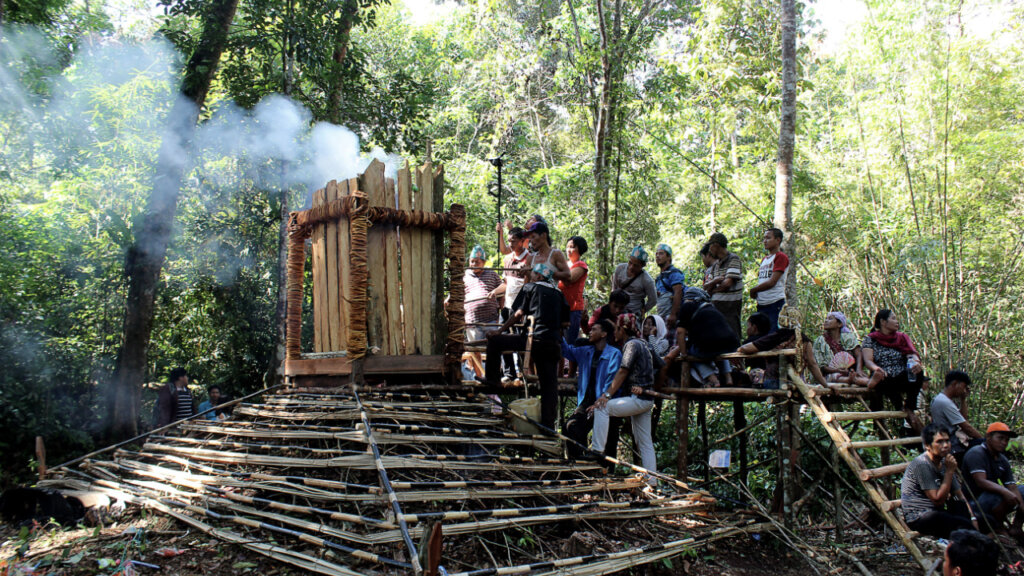
The other Dayak people we discuss are the Ngaju. They also are one of the largest ethnic groups of the Central Kalimantan province. According to Ngaju beliefs, the human body is infused with hambaruan, meaning a soul or spirit. Once someone dies the hambaruan vanishes but the corpse takes a new form called liau. This is the spirit of the dead body and consists of different parts. Liau does not belong in this world, therefore Ngaju priests have to sometimes perform rituals. As a result of these rituals, a deity (‘sangiang‘) accompanies the liau of the corpse to a heavenly village. The liau needs to stay there until the Tiwah, or Festival of the Dead.
The Tiwah is a secondary burial ritual. That means that it takes place after the initial burial. According to Ngaju customs, locals have to exhumate the bones of their relatives and purify them. Only then may the family place the bones of their dead into an ossuary. A typical Tiwah lasts anything between three to forty days and costs 6.000 to 180.000 USD! As a result, there usually are fewer than ten Tiwah events per year.
Furthermore, the Ngaju believe that only then can the different liau reunite one final time before the deceased fully moves on to the afterlife. Due to that, they organize a lavish feast that celebrates this reunion. The deceased will be soon reunited with their ancestors too. Another purpose of the Tiwah is to ensure the safety of the living who are in a vulnerable state, according to Ngaju traditions.
It is then when animal sacrifices take place. The blood of the animals cleanses the spirit of the dead, while the actual animal is consumed by the living for sustenance.
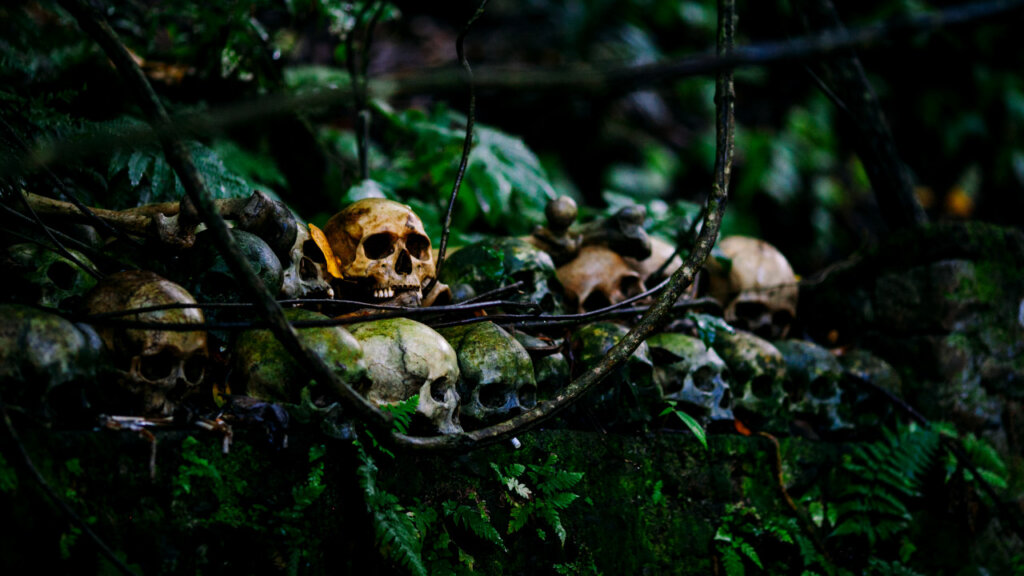
The Dayak are also known for their ossuaries – called sandung. These have elaborate decorations such as frightful faces in bright colors. Moreover, these faces function as protectors of the deceased. The average sandung can be anything between 1,2 to 6,1 meters (4 to 20 feet).
There are individual ossuaries (“sandung tunggal”) but most families build large ossuaries for all their deceased. This way the dead can create another household. Some Dayak peoples use an individual ossuary only in case the person died in an unnatural or ‘bad’ way. Because of that it is not appropriate for the deceased to join their dead relatives in the family ossuary!
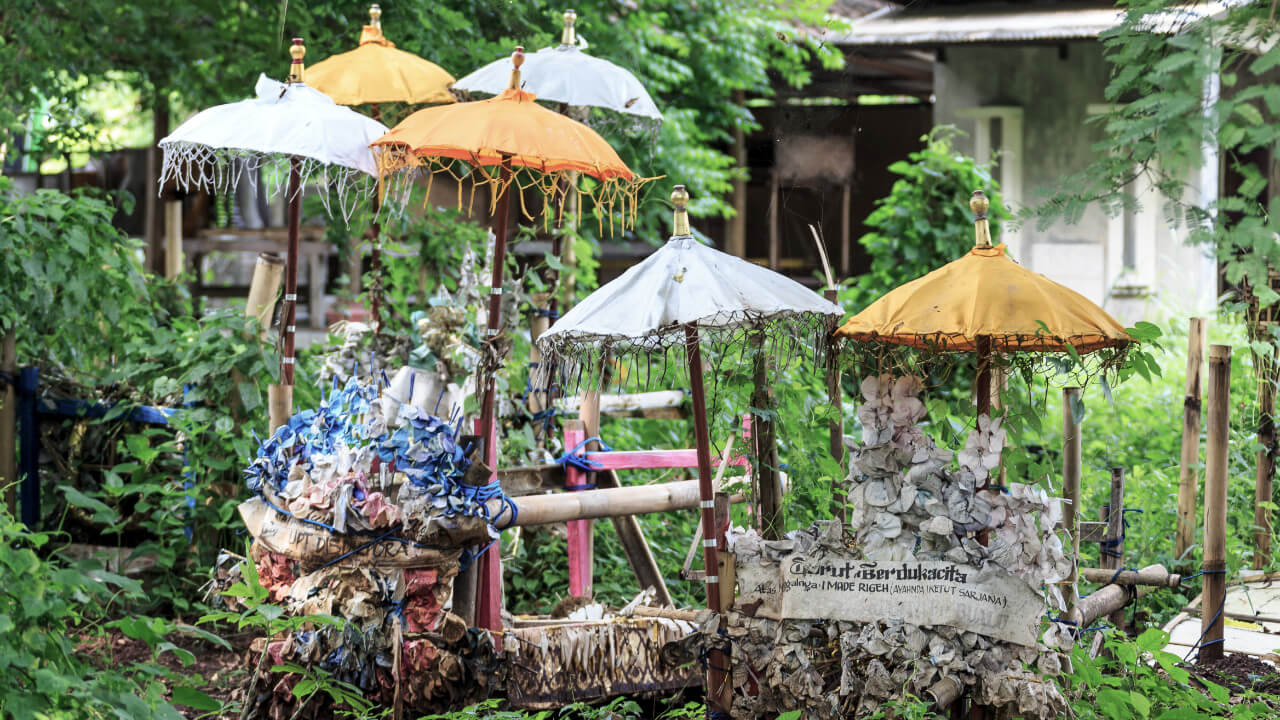
Most Indonesians of Bali are Hindu. However, Balinese Hinduism differs significantly from Indian Hinduism. That is also reflected on how they approach death and their customs.
For example, the Balinese do not cremate their dead directly after death. Instead, they temporarily bury their dead in graves that traditionally face the ocean. When they are ready to perform the cremation, the Balinese exhumate their dead. This takes place usually three days before the cremation ceremony.
Moreover, during these three days the family keeps their deceased at home. Priests, however, are never buried. Their relatives keep their bodies at home instead until the cremation rituals, regardless how long they have to wait. This could be a very long time since the final cremation ceremonies can be extremely elaborate and, therefore, expensive!
Furthermore, there is a grand feast after the cremation, adding to the expenses of the family. There are even stories of debt collectors confiscating someone’s motorbike as payment for a funeral loan they could not afford. As a result, although local authorities dictate that cremation should take place within two weeks after death, Balinese families often wait much longer collecting funds.
In addition to all of that, we should mention that Balinese funerals have a festive element. They usually include large processions too and the designated color of mourning is white. The most fascinating, perhaps, element of Balinese funerals is the Ngaben ritual.
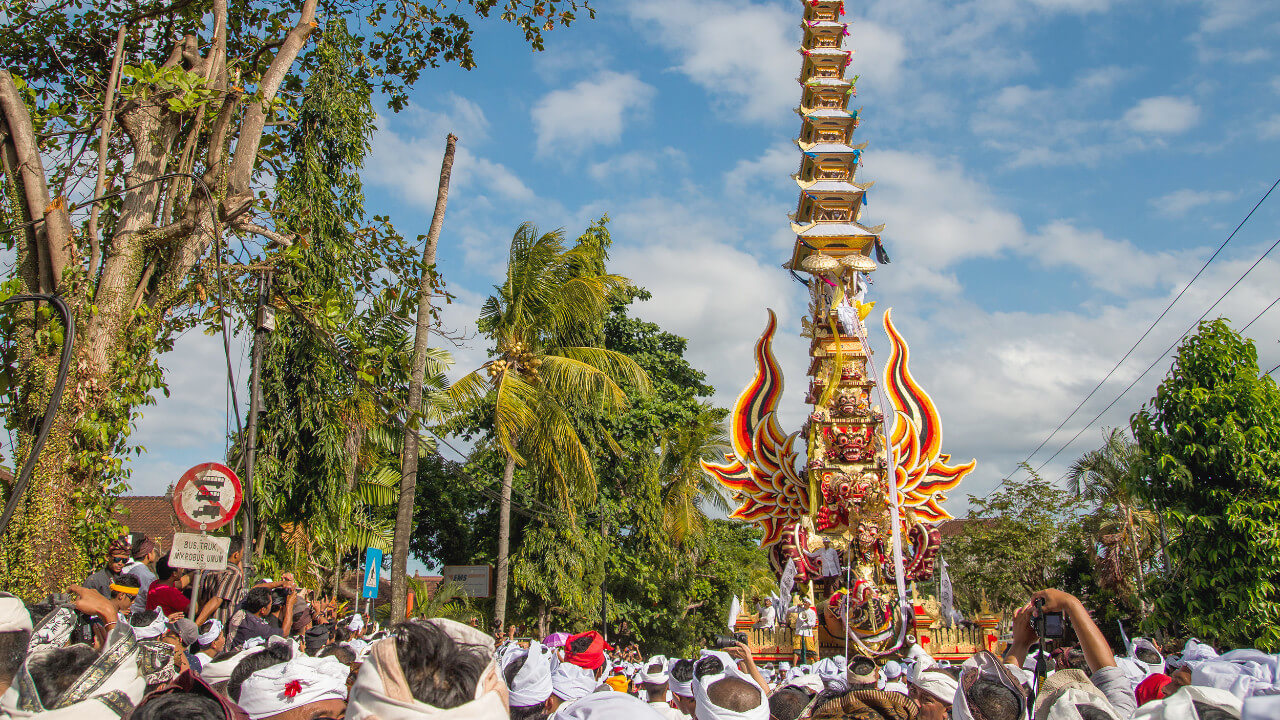
The cremation ceremony, also known as Ngaben, aims at purifying and releasing the soul of the dead. Only then can the soul move on to the upper realm.
That realm works as a waiting stage, so to speak, before the soul either reincarnates or becomes free of the cycle of rebirth. However, there is also a lower realm and evil forces are trying to trap the soul there. The role, thus, of Ngaben is to offer the correct funeral rites which keep the evil forces at bay. As a result, the soul gets better chances of reaching the upper realm instead.
But what does the ceremony include?
It is common that the whole village helps during the preparations of a Ngaben. As a result of that, it is an endeavor for the whole community. Once the preparations are complete, over 15 men carry the corpse and the rest of the village forms a procession behind them.
The family is responsible for making the coffin for the dead called a bade. Furthermore, they have to construct a patulangan. This refers to an animal-shaped coffin or a temple-like structure made of wood or bamboo and paper. Balinese burn the patulangan with the dead, making it a crucial element of a successful Ngaben. Before the cremation starts, the family makes sure that they have properly washed the body and dressed the dead in typical Balinese clothing. Furthermore, music, chanting and praying are always present during the ceremony. This genre is called gamelan.
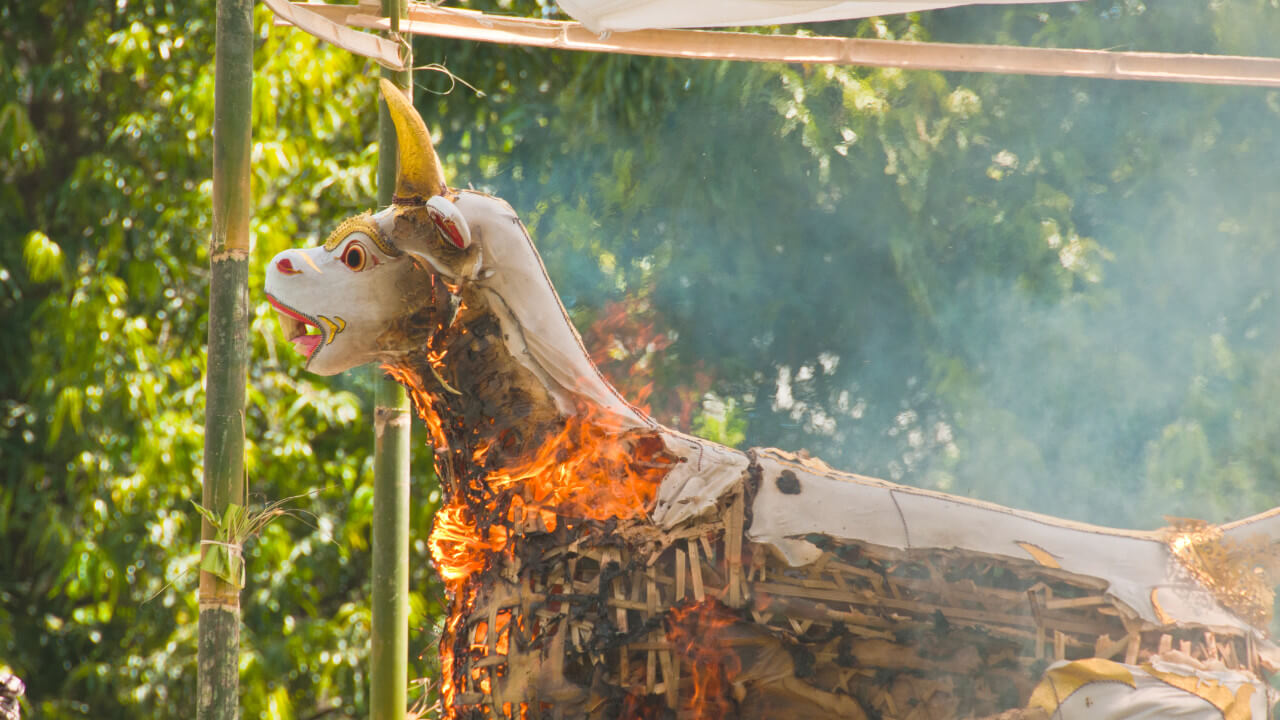
A local superstition dictates that if the procession reaches a crossroad, they have to turn the coffin three times. This aims to confuse evil spirits so that they may not intervene.
Once the procession reaches the cremation site, the Balinese place the dead in the patulangan. While the corpse is burning, the Balinese are playing beleganjur music which is a specific funeral genre. Specifically, it is a representation of the battle the soul goes through with the forces of evil in order to manage to reach the upper realm.
Finally, relatives gather the ashes of the dead, twelve days after the cremation. They also place the ashes in a coconut and release it to the ocean.
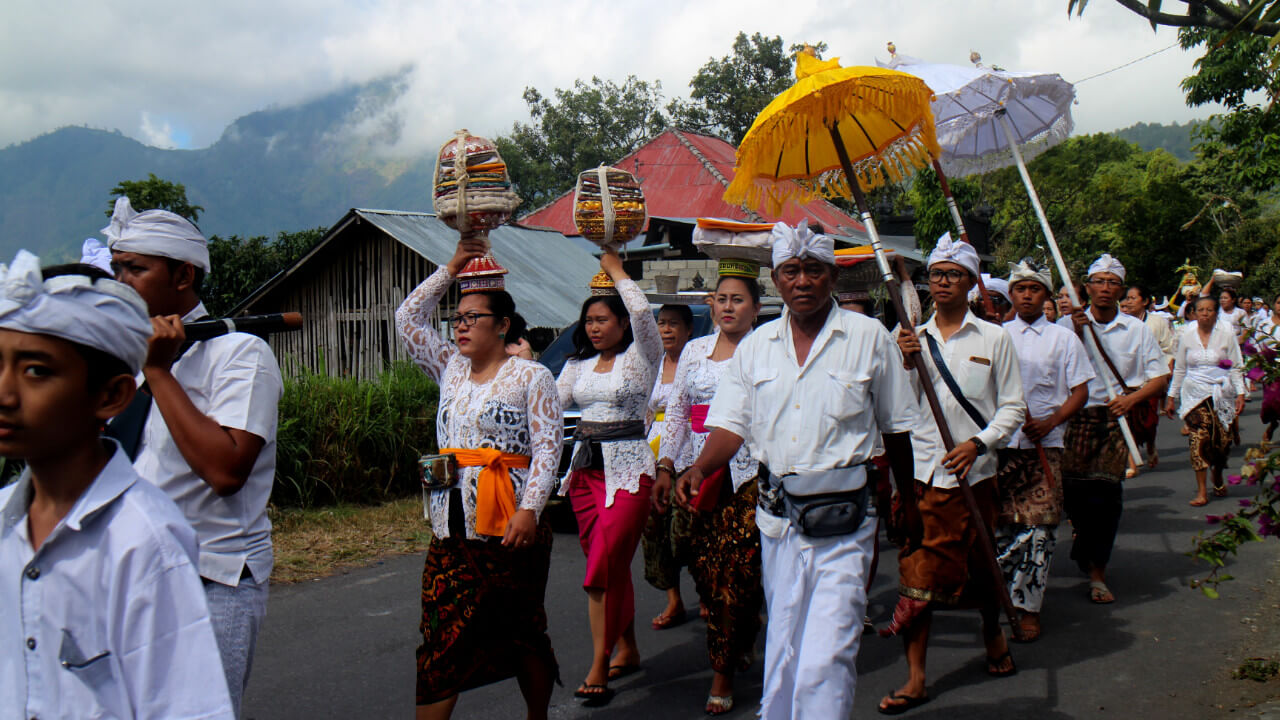
Moving to the Easternmost tip of Indonesia, our next step are the highlands of Western New Guinea. Specifically, we are visiting the Dani people of the Papua. To be clear, we are here referring to the Indonesian province of Papua, not to be confused with the country of Papua New Guinea. The Dani have historically had some extremely interesting (and gruesome!) death customs.
First off, the Dani used to smoke the dead, turning them into smoked mummies. Ancestors were of extreme importance to this tribe so preserving their bodies was crucial. They also often paraded the smoked mummies around the village. Although the death custom does not take place anymore, there still are smoked mummies at certain villages. The Dani also take care of the smoked mummies as a sign of respect.
For example, there is a dead chief called Agate Mamete Mabel whose mummy is still venerated. Local villagers support that the chief died over 250 years ago, but the mummy still has a prominent role. In addition to that, the descendant of the ancient chief is the present chief. Through Mamete Mabel, we also know more about the process of mummification amongst the Dani people.
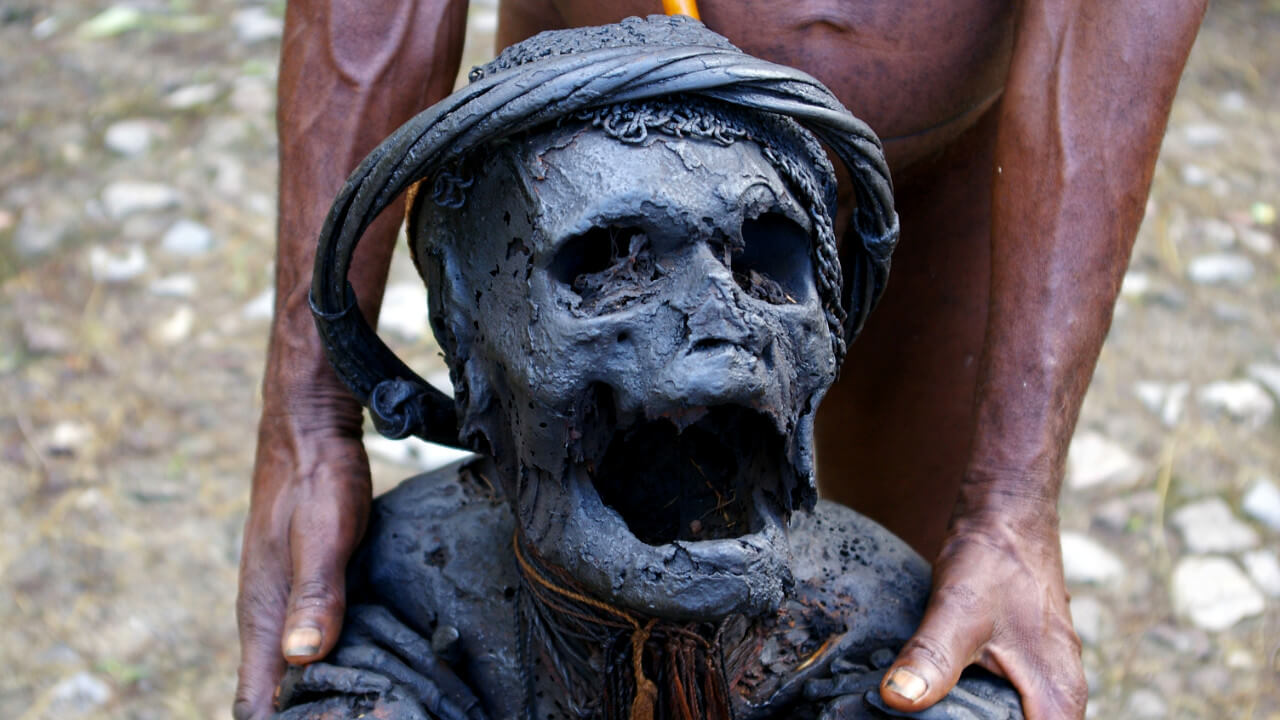
They would first dry the corpse out by placing it in the harsh sun. The Dani also used certain piercings to drain the fluids from the corpse. Thereafter, they moved in a cave and then smoked it for almost a whole month! Prominent members of the Dani society also got additional treatment, with men embalming their corpses with animal fat. Finally, the mummies were in a fetal position in order to look like a fetus in the womb.
The Dani believed that by mummifying their dead they would be blessed with prosperity and health. Nowadays, most Dani have converted to Christianity or Islam and because of that burials are the most common practice.
Another particularly interesting approach the Dani take when it comes to death, is how they view grief and pain. They specifically believe that the emotional pain of mourning has to be accompanied by physical pain. This is a natural way of grieving for them.
For example, some Dani amputate their fingertips when they attend the funeral of a loved one. If a child dies, then it is expected that the mother cuts off her fingertip. Additionally, the practice takes place to keep any evil spirits at bay in order to protect the village. It is also a physical manifestation of the sorrow the grieving relatives are experiencing.
Dani who perform that, first tie their fingertip very tightly for at least half an hour. As a result the reduced blood circulation makes the fingertip numb. This also makes cutting the finger off easier, or at least less painful. They then use an axe to cut off the fingertip and immediately cauterize so that they do not bleed out or get infections. Furthermore, the Dani are drying the cut-off finger and cremate it or keep it.
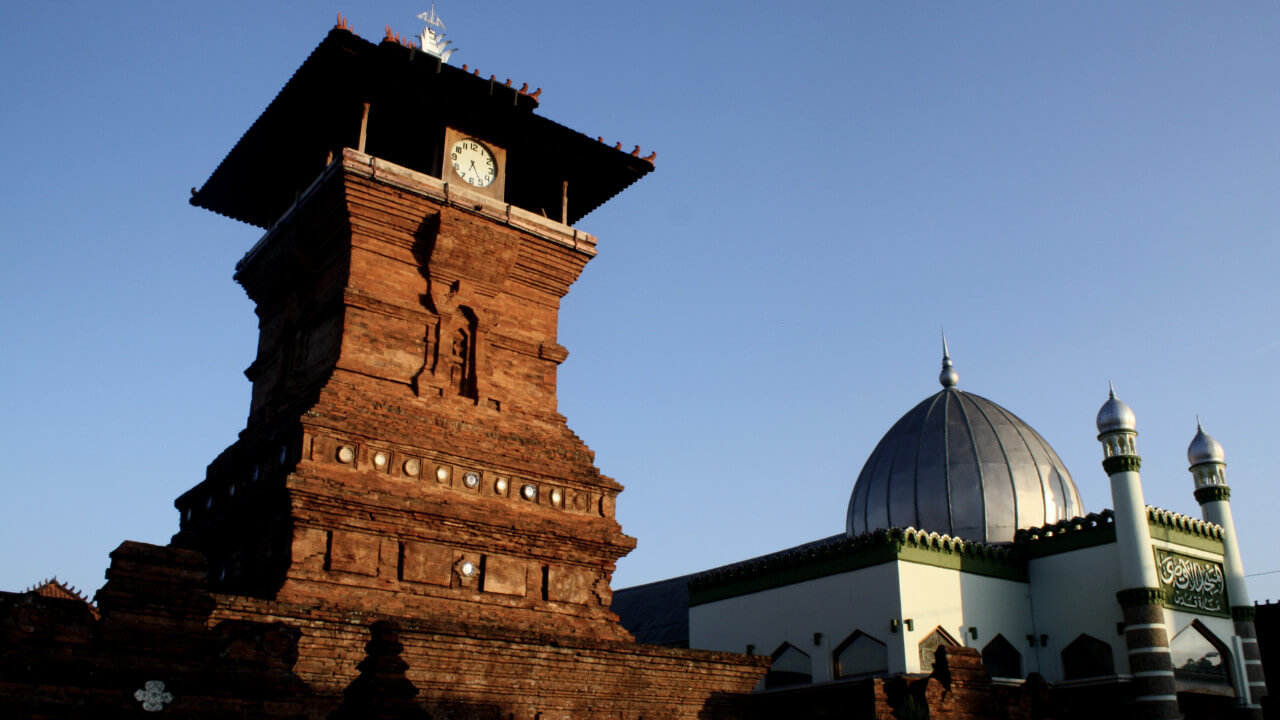
The island of Java is home to many different ethnic groups. We are now focusing on the Javanese ethnic group. For them death is almost always a social event. Although on paper most are Muslim (with a Christian minority), many Javanese incorporate traditional Javanist (‘kejawen’) elements to their approaches.
A characteristic element of Javanese approaches to death is the notion of acceptance and letting go. Researchers like Clifford Geertz point out that this is also often reflected on the calm and grounded nature of Javanese funerals. Letting go, also referred to as iklas, manifests in certain ways during the final rites.
For example, even being able to touch the corpse when cleaning it is seen as courageous. Additionally, it is family members that often carry the coffin to the graveyard so they can experience the weight of death on them – quite literally. They need to specifically feel the weight of a soulless corpse on their shoulders.
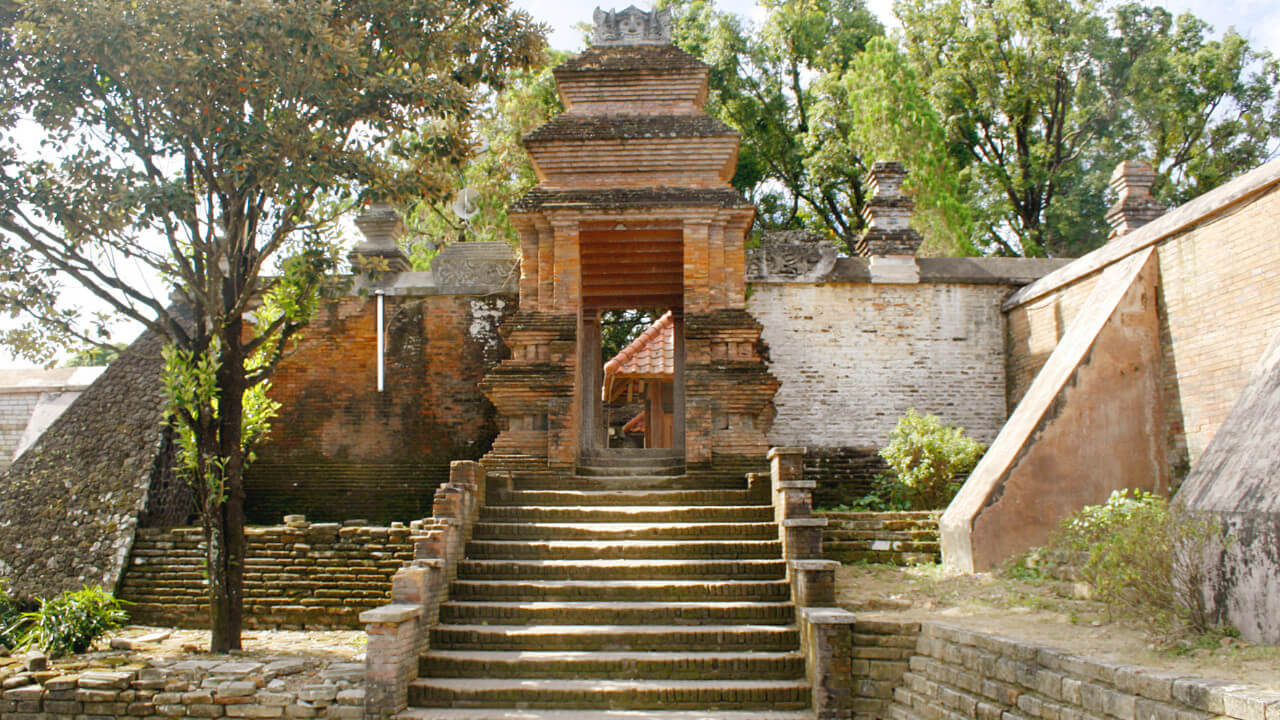
All we discussed above, are ways that Javanese process and let go of death. However, letting go does not mean forgetting.
For instance, the practice of nyekar refers to visiting the grave of a loved one with flowers. Therefore, the Javanese still maintain a relationship with their dead. It is especially the first year after death that the family needs to visit the grave often, because the relationship with the deceased is still close. Moreover, it is common that these visitations take place during Javanese or Muslim celebrations.
Furthermore, Javanese may visit their deceased if they need advice or their blessing for important life decisions. There are even certain offerings and prayers that need to be chanted on specific days after death. Finally, they have to place these offerings two times per day, for 40 days under the bed of the deceased.

Aceh is the westernmost province of Indonesia, located at the tip of Sumatra. Although, it is a stronghold of Islam with Sharia law dictating local life, there are notable exceptions. For example, Islam started spreading in Aceh during the 13th century. However, it did not fully reach populations, such as the Gayo people, until the 15th to 17th centuries.
An honorary mention of Northern Sumatra include the complex mortuary customs of the Batak people, a group of ethnic groups. This includes complex religion and burial techniques and even a tradition according to which women have to carry the dead body around the the house before transferring it to the cemetery.
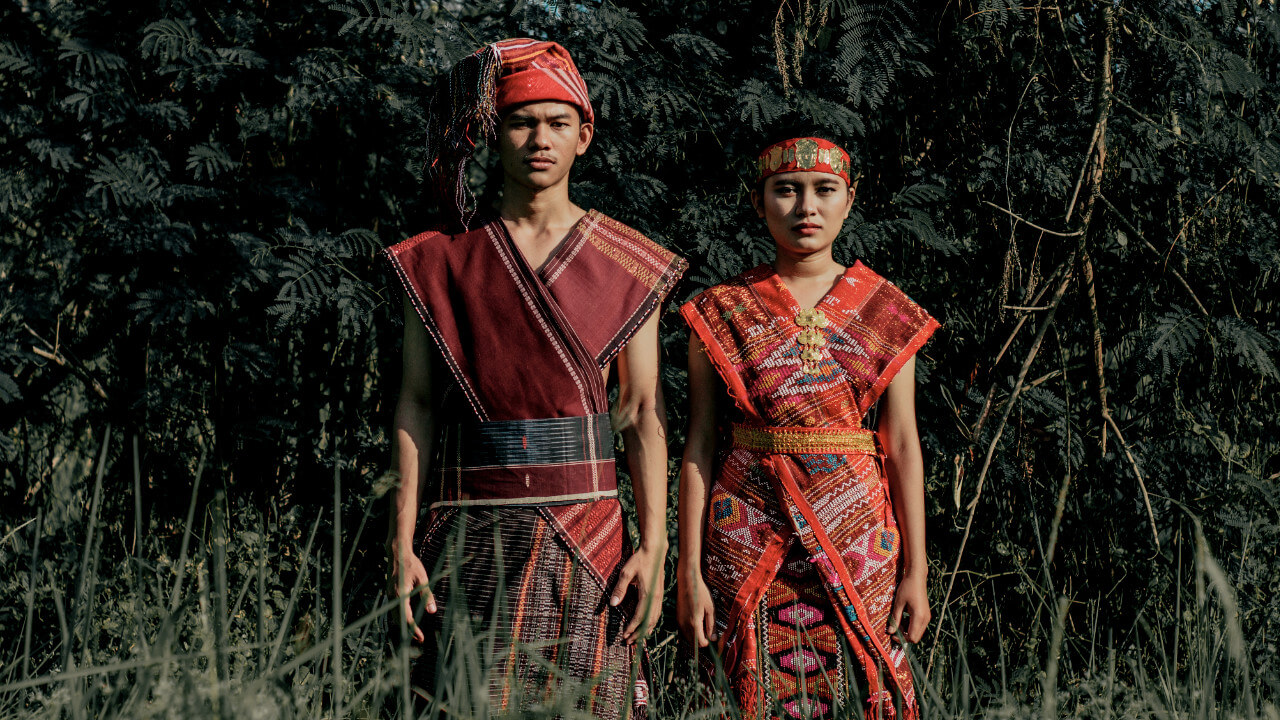
Focusing again on the Gayo people, their death views support that everyone has four souls. Additionally, the Nyawa is a soul linked to life and it permanently leaves the body upon death. That happens because of the angel of death who actually rips the nyawa out of the body. Therefore, it instantly stops being of importance since it is lost forever.
The semangat soul is also only relevant during one’s life. It is the soul that turns actions of, usually evil, spirits into negative states. Then there is ruh, the soul responsible for dreaming faraway places. The Gayo believe that it leaves the body often during one’s life. Finally, the fourth soul is Arwah. Gayo may see this as a separate soul or just as a continuation of ruh. They specifically believe that forty days before death, ruh turns into arwah. The arwah is the only important soul present after death.
Furthermore, the soul is not linked to the corpse anymore, but instead it is grounded to the burial site. The Gayo often turn to the souls of ancestors if they need help. However, the Gayo need to perform certain rituals to ensure that the soul of the deceased has a good relationship with the living.
The two main rituals are the kenduri, or in other words ritualistic meals, and the telkin, or instructions to the dead.

Relatives prepare the ritual meals on the 1st, 3rd, 7th, and 44th day after the death of their loved one. Every single villager is invited to these meals which makes them a very expensive affair. The role of a villager during these meals depends on their gender: Males have to chant while females help the family with preparing the meals.
The dead then receive the essence of the food (‘berkat’) and merit and respect through the chanting (‘pahala’). Additionally, Apam are small rice cakes that the family has to prepare. Notably, kro, or normal rice cakes, are for the living, while kunyit, or glutinous rice cakes, are exclusively for the dead.
It is during telkin that the importance of Arwah emerges. Arwah stays close to the body while the family is preparing it for burial. That includes washing it and engulfing it in mortuary white cloth. The imam offers prayers that mostly focus on reducing the sikse kubur, or ‘torment of the grave’. In other words, the goal is for the soul to be free of sin so it can rest in peace.
The imam then reads the text called telkin which includes the most important principles of their faith. After all, the word telkin comes from the Arabic talqin meaning instruction. Therefore, the living are quite literally offering instructions. It is specifically the Arwah soul that listens to these instructions.
During the beginning of the funeral the priest repeats three times that “everything that has a nyawa must die”. As a result, the Arwah goes back into the body and the deceased then feels that they are wrapped in mortuary clothing. It is at exactly this moment that the individual fully realizes that they are dead. Summing up, for the Gayo, telkin functions as a public statement of death but also highlights the existence of consciousness beyond it.
We hope you learned something new regarding this country’s death practices!
One of the most famous Indonesian funeral custom is that of the Toraja people of Sulawesi. We have dedicated an article exclusively on their elaborate rituals of exhumating and dressing their dead up!
For other Southeast Asian mortuary practices have a look at the Buddhist customs of Thailand and the hanging coffins of the Philippines. If you would like instead to read more about rituals and gruesome death customs of the island of New Guinea check out our article here.
The average mixed death rate in Indonesia is 6,51 per 1.000 people (2019). Interestingly, Indonesia’s death rate hit an all-time low in 1989 (6.418 per 2016), but it is steadily on the rise ever since.
The precise time of burial or cremation depends heavily on the ethnic and religious background of the deceased. For instance, Muslims tend to bury their dead as soon as possible, while Hindus in Bali cremate their deceased weeks after death.
According to the 2018 census, the vast majority of Indonesians are Muslims (86,7%). In addition to that, Indonesia is home to the largest population of Muslims in the world. Pancasila is a fundamental philosophical tenet of Indonesia governments and it refers to the conviction of the existence of God. In other words, one simply may not be an atheist or irreligious in Indonesia. In addition to that, Indonesia recognizes only six religions: Protestantism, Catholicism, Islam, Hinduism, Buddhism and Confucianism. Therefore, everyone who is not Muslim belongs to one of the other five religions with Protestants forming the largest minority (7,6%).
Indonesia has overcome many challenges in an effort to promote organ donation. However, the country is still trying to develop a successful National transplantation system. The numbers of kidney donors, for example, are steadily on the rise. Most of the procedures take place in big cities – mostly even in Jakarta.